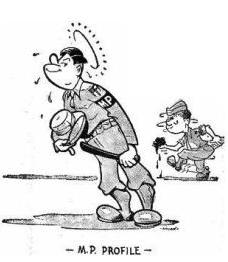
VOL. II NO. 21 REG NO. L5015 DELHI, THURSDAY FEBRUARY 3, 1944.
|
BOPPED BY EAC PLANES
Burma rail bridges this week bore the brunt of heavy attacks by U.S. bombers of the Strategic Air Force, Eastern Air Command.
On Jan. 29, mediums operating in the Katha area, northern Burma, hit the Meza River and Pyintha bridges, knocking the west end of the former out of alignment and causing severe damage to two of the piers supporting the center span.
The following day, the mediums returned for another whack at the Meza River bridge. This time they demolished three spans and completely wrecked the concrete piers. Other mediums also destroyed a rail bridge just north of Kyungon, knocked one end of the rail bridge at Zawchawng off its piers and wrecked a locomotive and tender in the vicinity.
TACTICAL MISSIONS
British and American units of the Tactical Air Force were active throughout North and Central Burma during the week, in spite of soupy weather. In the Hukawng and Chindwin Valleys, the Chin Hills and the Arakan, harassing attacks were made daily by fighters and dive bombers against Japanese troop concentrations, supply dumps, rail junctions, road and river traffic.
On Jan. 29, acting in support of ground operations, U.S. mediums bombed and strafed a three-mile strip of road running south from Taipha Ga, in the Hukawng Valley.
Meanwhile, in southern Burma, U.S. heavies of the Strategic Air Force were attacking the oil installations at Yenangyaung, on the Irrawaddy, 90 miles east of Akyab, despite unfavorable weather. The B-24's, escorted by fighters, dropped a heavy load of demolition and incendiary bombs on the gasoline and topping plants, causing considerable damage and starting fires.
RANGOON ATTACKED
On the night of Jan. 28-29, RAF heavy bombers attacked Rangoon, starting several fires in the neighborhood of railway installations.
A strong force of American medium and heavy bombers, escorted by RAF fighters, delivered a heavy blow against a Japanese camp near Rasabil on the Mayu Peninsula, on Jan. 26. RAF dive bombers operating in direct support of ground troops, also attacked enemy positions near Maungdaw.
7,700 AMERICANS IN JAP HANDS DIE
Brutality Told By Prisoners Who Escaped
WASHINGTON - A story of Jap brutality to prisoners of war which already has cost the lives of at least 7,700 captured Americans was released this week in a joint statement by the United States War and Navy Departments.
Based on the sworn statements of three American officers who were captured but later escaped, the joint document told a tale of savage cruelty to defenseless prisoners which has stirred the American public to a new pitch of fighting fury, immediately reflected in a tremendous upsurge in war bond buying and other civilian war activities.
One of the three ex-captives, Lt. Col. William E. Dyess, of the Army Air Corps, who has been killed in a fighter plane crash since his statement was made, was captured at Bataan and forced to take part in an infamous "march of death" to a prison camp 85 miles away.
GRIM STORIES
The other two, Cmdr. Melvyn H. McCoy, of the U.S. Navy, and Lt. Col. S. M. Melnik, of the Coast Artillery, were captured at Corregidor. The sworn statements of the three include no hearsay but only first-hand observations which have been verified from other sources.
Dyess' story was the grimmest of the three. He described how Bataan prisoners, without rest after weeks of desperate fighting, were beaten with whips, clubbed with rifles, bayoneted at the slightest sign of disobedience, marched for hours under a blazing sun, and quartered at nights in bull pens so crowded that no one could lie down. Although they passed many Jap food dumps, the total ration of this party was one mess kit of rice per man in six days. The only water they got was from caribou wallows and roadside ditches.
SOLDIERS BAYONETED
Stronger marchers were not permitted to aid weaker ones who collapsed from hunger, fatigue, heat and thirst, and those who collapsed were shot. Six thirst-crazed soldiers who made a break for a roadside well were bayoneted before Dyess' eyes. An American colonel who begged for food for his men was answered by having a salmon can smashed brutally into his face.
At Corregidor, 12,000 prisoners - 7,000 Americans and 5,000 Filipinos, including walking wounded - were crowded into an area 100 yards square and kept without food for one week. When they later reached camp, the death rate a week after arrival was 20 daily for Americans and 150 daily for Filipinos. A week after that the rate had jumped to 50 daily for Americans and 500 for Filipinos. "It is impossible," the statement said, "to convey an impression of how horrible conditions really were."
ALL EFFORTS FAIL
Although the statements of the officers have been in the War and Navy Departments hands for some time, they were not made public until every effort had been made to get help to surviving prisoners through international agencies. In explaining why they are made public now, White House Secretary Stephen T. Early said: "The government can no longer expect to get further relief to American prisoners of war in the hands of the Japanese."
In contrast to the 7,700 known dead among American prisoners in Japanese hands, not one Jap war prisoner held by the U.S. has died, according to the United Press.
STARS FALL ON CBI-LAND
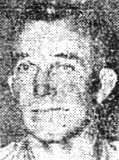
|
DAVIDSON PROMOTED TO MAJOR GENERAL
Four new sets of glittering stars fell on the CBI Theater this week, three of them supplanting the chickens of erstwhile colonels and the fourth metamorphosing a brigadier into a full-fledged major general.
The new major general is Howard C. Davidson, commanding the Strategic Air Force of the Eastern Air Command. The new brigadier generals are Robin B. Pape, formerly G-2 of the CBI Theater and now of the Intelligence Section of the SEAC; Thomas F. Farrell, Chief Engineer, SOS; and Thomas O. Hardin, commanding the Eastern Sector, India-China Wing, of the Air Transport Command.
Davidson arrived in CBI-land last August to replace Maj. Gen. Clayton L. Bissell as commanding general of the 10th Air Force, which since has been merged onto the Eastern Air Command.
Road To Mandalay
DIFFERENT FROM KIPLING'S DAY
By Sgt. AL SAGER Traveling Roundup Correspondent
EASTERN INDIA AIR BASE - The other day I passed over the Road to Mandalay. No sarong-draped Lamour or crooning Crosby accompanied me on this trip. Unlike the Road to Morocco, the Road to Zanzibar or, for that matter, any other road trip dreamed up by the movies, the journey was made in a modern chariot, a medium bomber of Maj. Gen. Howard C. Davidson's 10th USAAF.
High-candlepowered flashlights glared through our mosquito bars at dawn to signal our awakening for the mission. Flying togs and boots went rustling on. A dash followed to the air-conditioned shower room for a dab of pani. Mess kits in hand, it was a rush for the usual morning chow of coffee, French toast and bacon.
Tall, Atlas-like Maj. Robert McCarten, commanding officer of this "Skull and Wing" bomb squadron, gave the men a final pep talk in the briefing room. Here they also received instructions about the target, the bomb dropping intervals, radio frequencies and other pertinent data.
HANDED MONEY BELT
After briefing, T/Sgt. Montie Johnson handed cameraman Frank Amelia and me a cloth belt containing silver rupees to be used to repay inhabitants for favors and food should we be forced to hit the silk over occupied Burma. If we had to bail out too far into the territory, of course, all the rupees in the world wouldn't have helped us. We'd just be an obituary line in the Tokyo Times.
A tall youngster dressed in a pilot's garb stepped toward us, as we both hoisted aerial cameras and prepared to hop a six-by-six.
"I'm Lt. Bob Ewald and understand you're coming along on my ship today. I don't know why in the hell you'd wanta go over there, if you don't have to, but if you've got your insurance paid up, we've got a lotta room."
FROM SAME STATE
A truck-ride conversation revealed that Ewald is from Michigan across the lake from my home in Illinois, and everything from the Chicago White Sox to Willow Run found its way into the chin session.
The day was almost perfect, cloudless and warm, the sun shining brightly on the big twin-engined bomber and making the 75-mm cannon in the ship's nose stand out like a sore thumb.
The crew chief and ground men pulled the props through and soon both engines were roaring loudly, vibrating the entire ship. The ground crews waved 'good luck,' and we began to taxi out of the revetment onto the runway itself.
One, two, three, four, five, six ships took off, and then over the radio came the signal for our bomber to get away, as the lead ship of the second flight. Ewald served up the engines in a final warm-up, the brakes were released and a couple tons of bombs and a B-25 thundered down the runway. Faster and faster we went, 60-70-80 until finally I felt the morning's French toast settle suddenly. A glance out of the window told me we had left the runway.
Looking to my right I could see that more ships had joined our formation while above a fighter escort formed top cover. Circling the field once, we headed eastward against the rising sun.
The formation soon spread out like Jacob's ladder, with our ship the middle rung. Pilots to the right and left kept a steady watch for any deflection in speed or direction of the ships, and the formation soon grew tighter than the zone defense used in basketball.
The waist gunner called me forward and let me take over one of the 50's for a practice fire. There are two waist guns and a top turret close together, but only two men to operate them, which meant I had to help out.
The feeling of a man on his last thirty-nine steps to the electric chair gripped the entire crew, knowing the 1,001 things that might happen.
The topography of the ground below changed and, from the plane, now riding 11,000 feet above the earth, I could pick out thickly-forested mountains typical of the India-Burma line.
The mountain ranges below gradually became higher and a sip of oxygen cleared my head considerably. The nervous tension was evident all about me.
Then word came over the interphone that in 30 minutes we'd be over the target. Sirrus and cumulous clouds appeared below but, through breaks, buildings could be noticed, which meant only one thing, Jap concentration points.
Again, the topography changed quicker than a flip of pages in Rand McNally's Atlas, and a huge area laid off in perfect squares proved to be Mandalay! "This is your Mandalay," Ewald shouted over the interphone.
The land of flying fish and the dawn that comes up like thunder was 11,000 feet below, but it was far from the romantic spot described by Kipling.
before the Jap invasion, Mandalay was a picturesque pagoda-dotted spot. Trolley cars, donkey carts, oxen, bicycles and people rushed back and forth in the busy city on the Irrawaddy River and had made it a busy little metropolis. The palace grounds of the Burma kings stood in the center of town, and temples and pagodas were mushroomed throughout the area.
The Japs, with their plundering, and the fifth columnists, who sacked the town, left Mandalay a deserted, charred mass of ruins. Only a few stone temples, the old palace of the Burma kings, and the most that ran around the old fort now remained. The Rising Sun and not the dawn had come up like thunder!
Now we were seeing the city as an important river port to the Nips . . . another target for this bomber crew.
Leaving Mandalay behind, we continued to our target, dropped our full bomb load, and continued on a zig-zag course through the ack-ack coming up to meet us.
Over the interphone came the startling report, "Zeros approaching from the rear at two o'clock."
The waist gunner, top turret gunner and tail gunner immediately sprang into action and, grabbing the aerial camera and facing it to the window, I did likewise. By observing the waist gunner, I could see something was coming up from below and to the rear of the ship.
Like a bolt of lightning, only faster, the Zero flipped over, its red-circled wings flashing brightly in the noon-day sun. It made a pass at our ship. Another Zero followed him up and, as he passed our ship, he faltered and plunged earthward. One of the gunner's burst had caught him squarely.
The Zeros made pass after pass at the formation, but stayed away from our ship now, concentrating their fire on the wing ship to our left. Then word came over the interphone that our top cover had engaged the Zeros, approximately 25 in all, and we breathed easy again.
Soon the wood-blanketed hills and dense jungle were below us again, bringing to mind the thought of what a Herculean task lies ahead for American and Allied forces when the revenge for what Lt. Gen. Joseph W. Stilwell termed "most embarrassing Burma retreat" occurs.
Then we were back at the field, peeled off and landed. Truck convoys took the crews back to the Intelligence Room for the final report. Frank and I headed for the latrine and the Chaplain's office.

A year and eight months ago, Lt. Gen. Joseph W. Stilwell made an historic promise at Imphal, an Indian village nestled among peaceful rice paddies only a rifle shot from the Burma border. At the head of a tattered, polyglot band of 114, he had marched out of Burma on foot and a prayer from Indaw, 150 tortuous miles away, before the flood of Jap conquest sweeping northward. It had been a grim foot race against the double-edged threat of the impending monsoon and the possibility of the enemy's cutting off his flight, either by sending troop-laden boats up the Chindwin River or reaching out with an intercepting tentacle from Lashio. Uncle Joe, now safe, was no apologist. "They licked the hell out of us," he admitted candidly. "It was humiliating." But, promised the CBI commander, he'd return one day.
Today, Uncle Joe has made good his vow. During part of the past month, he personally directed American-trained Chinese troops screening the advance of the lengthening Ledo Road. It isn't to be construed as the official opening of the campaign to retake Burma, but, in the final reckoning, it will have played its part.
His cropped hair, standing up like the quills on an angry porcupine's back, is a little greyer than when he took over the American Baptist Mission in Maymyo, Burma, in 1942. But Stilwell, at 60, proved that he can still out-walk and out-work most of the younger men on his staff.
These pictures, a welcome gift to the Roundup from Bob Bryant, International News Photo cameraman, graphically demonstrate the CBI Theater commander's keenness to pay the Jap back in kind.
Darrell Berrigan, United Press correspondent, who was with Stilwell in Burma, returned recently from the jungled Hukawng Valley, where the Chinese are driving the Japanese from their defensive entrenchments. He told the Roundup of Uncle Joe's hiking 14 miles to the front, clambering in and out of captured trenches filled with the stench of dead Japs, following a labyrinth of newly-dug Chinese trenches and halting at an observation post cut into the river bank. From there, through a thin screen of leaves, he and Lt. Gen. Sun Li-jen, Chinese divisional commander, studied the other side of the river bank, 200 yards away, where the Japs were dug in. Another 200 yards to his right was a settlement of enemy pillboxes which the Chinese had been battering for days.
The general wore a doughboy's tin helmet, for which he had temporarily abandoned his famous campaign hat. He carried a carbine slung over his shoulder. He studied every foot of captured trail and jeep-track cutting the dense jungle growth. He interviewed every Chinese officer commanding any phase of the present advance. He hiked, doughboy fashion, 14 to 15 miles. At other times, he jeeped with Pfc. Windom Braud over trails newly cleared through jungle bogs. He slept in crowded bamboo bashas and ate with men and officers in open-air mess halls or on the trail. In short, he had one helluva satisfying time out on the field of combat.
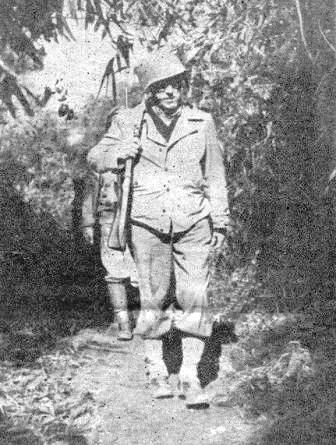
|
|
|
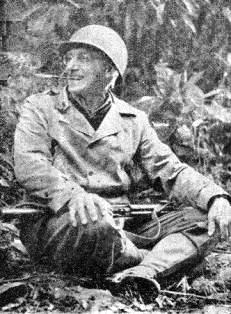 During a 10-minute break, the general sits down to rest, puffs a cigarette reflectively through his ever-present
cigarette holder. A loaded carbine rests in his lap, ready for instant use.
During a 10-minute break, the general sits down to rest, puffs a cigarette reflectively through his ever-present
cigarette holder. A loaded carbine rests in his lap, ready for instant use.
|
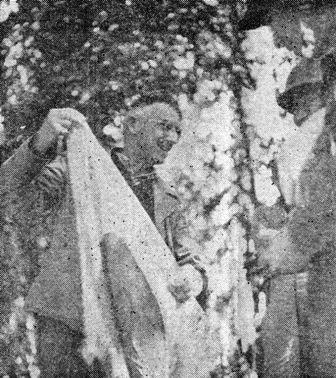 Col. Lee Huang presented the general with this Jap flag taken from one of the enemy dead. Stilwell, who reads Japanese,
was able to read the inscriptions written upon it.
Col. Lee Huang presented the general with this Jap flag taken from one of the enemy dead. Stilwell, who reads Japanese,
was able to read the inscriptions written upon it.
|
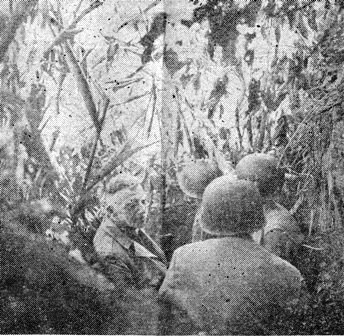 Jap positions are only 200 yards away across a jungle stream as Uncle Joe peers through a screen of camouflaging
leaves. Two hundred yards to the right is a concentration of stubborn enemy pillboxes.
Jap positions are only 200 yards away across a jungle stream as Uncle Joe peers through a screen of camouflaging
leaves. Two hundred yards to the right is a concentration of stubborn enemy pillboxes.
|
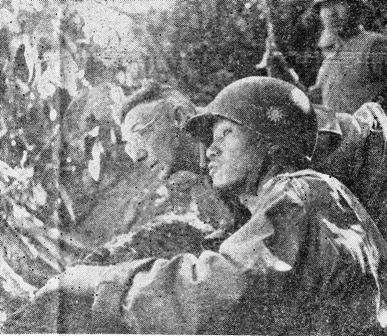 Stilwell is joined by Gen. Sun in looking at the Jap positions. Sun's American-trained Chinese troops, some of whom
fled from Burma with Uncle Joe, were groomed for combat at a base somewhere in India.
Stilwell is joined by Gen. Sun in looking at the Jap positions. Sun's American-trained Chinese troops, some of whom
fled from Burma with Uncle Joe, were groomed for combat at a base somewhere in India.
|
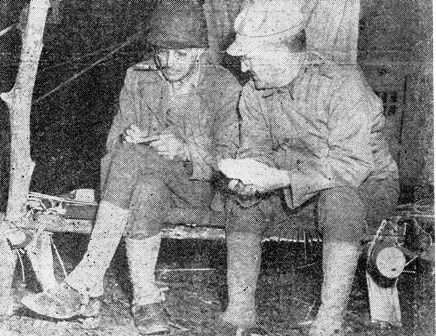 The general confers in front of his tent with one of his most capable lieutenants, Brig. Gen. Haydon L. Boatner,
swashbuckling former Marine whose intense, earthy vocabulary is matched only by his desire to annihilate the Japanese.
The general confers in front of his tent with one of his most capable lieutenants, Brig. Gen. Haydon L. Boatner,
swashbuckling former Marine whose intense, earthy vocabulary is matched only by his desire to annihilate the Japanese.
|
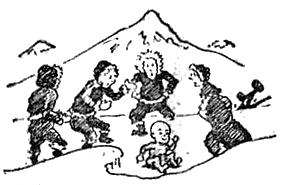
|
Five ATC Crew Members Forced Down in Tibet
By GEORGE PALMER United Press Correspondent
ATC HQ., EASTERN INDIA - Five young American airmen, the crew of an ATC cargo plane, returned here safely after 43 days in the forbidden land of Tibet, where they were forced to bail out. Miraculously, all were well and healthy.
Two officers and three enlisted men eagerly tore into huge Army steaks after their thrilling but hazardous experience of existing on Tibetan bread, yak milk and occasional portions of mutton and boiled rice.
Pilot of the huge, four-engined B-24 cargo ship was Lt. R. E. Crozier, 23. Others with him were F/O Harold J. McCallum, 24, co-pilot; Cpl. Kenneth B. Spencer, 19, radio operator; Cpl. William Perram, 23, engineer and Pfc. John H. Huffman, 27, assistant engineer.
These airmen represent five of only 10 Americans ever to visit the Tibetan capital of Lhasa, and their plane was the first ever to fly over the Holy City of Lhasa. They are the first Americans since the beginning of time ever to visit the remote outpost village of Tsetang, which was their first contact point after they bailed out.
LOST ON FLIGHT
Lost over northern Burma on a routine flight from India to China during bad weather, they flew above the overcast on a moonless night and could not even see the horizon. They had no radio contact and merely flew until their fuel was exhausted. Then they put the plane on automatic pilot and jumped. The altimeter reading was 17,500 feet, but all five estimate that they were only 400 or 500 feet above the mountainous terrain, as it took only a few minutes for them to strike rocky ground.
The plane burst into planes upon striking the ground and, after the airmen contacted each other, their long, cold march out of Tibet was made via horse and pack mules during a 30-day trek. Huffman suffered a wrenched shoulder when his foot became entangled in the parachute shroud lines as the 'chute opened.
Perram suffered a bruised leg when he landed on the rocky mountainside, and also obtained mildly frost-bitten feet during the march, but otherwise no injuries were suffered by the five airmen.
carrying the Tibetan boots they wore on the long trek, the airmen were proudest of the brass Tibetan earrings and souvenirs they obtained. All are eager to rejoin their outfit, somewhere in Assam.
The survivors were most anxious to see movies and learn the score of the Army-Navy football game. They were given several days' rest before returning to Assam.
After rough weather had driven them off course returning from China, Crozier flew on instruments nearly two hours over one of the world's roughest regions under the most difficult conditions imaginable before ordering the crew to abandon ship at 10 o'clock at night, while they were approximately 60 miles southeast of Lhasa and 90 miles north of the Bhutan border.
The night was dark and their radio was unable to contact any American base. The weather was hazy and it was impossible to see the horizon. They flew on desperately trying to find some sort of bearing until finally, with the altimeter reading 17,500 feet, McCallum reported a large cloud formation looming up on the right side. A moment later, he shouted: "Dammit, that's not a cloud, it's a mountain!" At almost the same instant, Spencer, who was looking out on the left side of the plane, reported large mountains there, too. At precisely this time, the fuel supply was practically gone.
When asked what he did next, Crozier smilingly said: "I threw her into a 180 (reverse turn) and got out of there."
For the next ten minutes, the airmen calmly helped each other don parachutes for their first jumps, and, as Perram explained, 'That was one time I didn't make any mistakes. It was the first time I ever had one on, but I sure made certain that I had it on right. Brother, that parachute silk floating over my head looked better than it ever would on any woman."
Crozier, Spencer and McCallum landed in the same area and later found each other by shouting. Spencer said: "We did not have much trouble making our shouts heard, thanks to the clear, cold night air."
Perram landed hard against the mountainside and suffered a bruised leg and spent three days and nights alone without water, eating only the chocolate bars and emergency rations from his jungle kit. Perram said, "My leg hurt and I could hardly move but I started down the mountain and came to a cliff and had to go back up again. Three days later some Tibetan natives found me and took me to Tsetang where I found Huffman had just rejoined the others two hours earlier."
Huffman and Perram both saw the plane burst into flames and told how the surprised Tibetans hastily salvaged bits of aluminum for pots, pans and knives.
The fliers' first contact with an English-speaking person in this land of mystery was with a Bhutanese monk in Tsetang, where the natives, who had never seen an American, grouped all day long around the airmen, tugging at their clothing to see what it felt like.
TREATED SPLENDIDLY
Probably one of the most curious of the situations was the one in which the five Americans left their ultramodern airplane and found themselves not only mingling with these primitive people who have no sort of wheeled vehicles, but both parties were actually enjoying each other's company.
They said the Tibetans helped them in every was possible, giving them Tibetan boots, fox-fur coats, fur lined Cossack caps and inviting them to sleep in their crude mud huts.
They were treated royally by Mr. Rangang, a graduate of Oxford, who is the Tibetan minister of foreign affairs. He arranged transportation and after 10 days in this strange town of Tsetang, where previously no American had ever been, they began the strenuous 30-day trek with pack-horses.
There were no roads, only narrow mountain trails, filled with jutting rocks and swirling snow. These pack trails, winding their way through and amongst 25,000-foot peaks, are devoid of all signs of civilization except for staging huts, which are strung out and spaced such that the distance between each mud hut represents one day's travel.
SLOW TRAVELING
It is practically a physical impossibility to travel more than four or five hours a day because of the altitude and cold.
However, because of their eagerness to return to India, the airmen "double staged" the entire journey. By changing horses every two or three days, they were able to average 30 to 35 miles daily and completed the two-month trip in 30 days.
Crozier said, "Naturally, we were aware of the terrific cold, but those fur coats were life-savers. They were made of beautiful fox fur and the Tibetans were going to let us keep them, but we knew they had better use for them than we did, so we returned them. We kept the fur caps and boots for souvenirs."
Huffman said, "That's the damndest country you've ever seen. They don't know there is a war on - and don't give a hoot."
The last Americans previously in Lhasa were two Army officers who were sent there in 1941, seeking a new supply route to China.
The airmen were impressed by the complete lack of Western civilization. Perram said, "There's no gas, no cars and, in fact, we did not see a thing with wheels on it. The natives who brought me off the mountain had no matches and started fires by tapping a special kind of stone together and lighting twigs with the sparks.
They traded parachutes and pieces of parachute shroud lines and knives for food but Spencer explained, "That was merely a gesture on our part. They were eager and happy to feed us gratis."
Tibetan food consisted of bread, mutton, boiled rice, yak milk, and cups of Tibetan tea, decorated with generous dashes of butter. Nightly they slept on mats of the floors of mud huts and managed to keep warm with fur jackets and blankets.
At one point in the journey - the town of Gyantse - Crozier, Ferram and Huffman, all contracted slight cases of influenza and stayed at a British encampment (still mud huts) and were treated by Indian doctors. Nonetheless, all five looked amazingly healthy. Perram's leg and Spencer's shoulder have healed. McCallum said, "We all had head colds, off and on, the whole time, but I guess we did pretty well, considering that it was frequently 15 to 20 degrees below zero."
NO MORE COMPLAINTS
Huffman added, "One morning we stepped out of our hut into 15 below zero weather and saw a tiny Tibetan infant playing outside completely naked. We decided then that we were sissies and didn't complain anymore."
The airmen said that what impressed them most about the Tibetans was the fact that they bathe only once a year. In July everyone takes a week off to hold a mass bath in the rivers and streams.
Clean-shaven today, the airmen bet on who would grow the best beard. At the journey's end each insisted his was the best so they called off the bet under a mutual agreement. All are anxious to see some movies and return to their base in Assam, where they can show their buddies the new Tibetan currency they have added to their short-snorter bills.
Speaking for all, Crozier said, "The Tibetans are very primitive, but very fine and friendly people. They practice isolationism in earnest and merely want to be left alone. They treated us well."
G.I.'s in Assam Start College for Three Men
ASSAM AIR BASE - Life is only dull if you let it get that way, and ability to "find something to do" depends on the ingenuity of the seeker.
That, at least, is the opinion of three never-say-die G.I.'s of this air base, who have decided that not even the war nor the fact that they are immured in the jungles of Upper Assam is going to prevent them from getting something out of their Indian sojourn worth taking home with them.
Therefore, the three, Cpls. John Payne, who holds a Master's degree from the University of Cincinnati; Tom Mooney, a junior at Washington University when Uncle Sam called, and Charles Katan, who was about to enter college when inducted, have organized the ". . . . University" here, in which they hold regular classes for their own amazement and instruction and as an antidote to boredom.
ONE INSTRUCTOR
The only instructor in this informal seat of learning is a well-educated local citizen who gives daily lessons in Hindustani. For the other "classes" in the curriculum, each member of the trio specializes in and lectures (to the other two) on a separate phase of indigenous lore.
Payne specializes in Indian geography, Mooney lectures on history, and Katan delves into Indian legend and customs. Educational tours throughout the surrounding countryside replace the laboratory periods of an American college.
'QUIZ KIDS'
Already the three have acquired a fair working knowledge of Hindustani and can pass as local "quiz kids" on the other subjects engaged in. Not only that, but the G.I.'s feel that their enterprise has saved them from poverty as well as boredom - for it has kept them too busy for all-night poker games, overdoses of jing-bow juice and other traps and pitfalls which beset the unwary in this particular section of the United Nations' far-flung fighting fronts.
Life Saved
CHINESE GENERAL GETS AID FROM U.S. MEDICOS
GEN. STILWELL'S HQ IN CHINA - By performing an emergency operation under circumstances usually encountered only in novels, two American medical officers recently probably saved the life of Chinese Gen. Chao Yao-ming, one of China's outstanding army commanders.
Rushed by airplane and jeep deep into the mountains of South China on the emergency mission, Capt. H. L. Stowe, of Twin Falls, Id., assisted by Capt. Dubose Eggleston, of Augusta, Ga., performed a two-hour appendectomy on the general by the light of a rude lantern in a mud brick building behind the battlefront, beginning at 2:00 a.m.
"We found a bad gangrenous appendix with an abscess," Eggleston said in describing the operation.
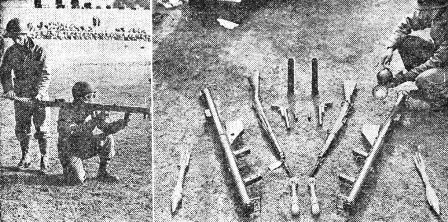 And here are two pictures of the bazooka. Two soldiers, left, demonstrate how the Army's new anti-tank
weapon operates in the field. The standing member of the team loads the rocket projectile into the rear of the
weapon being held by the kneeling G.I. In the second panel, the bazooka is shown along with rifle projectors,
Very pistols and flare projectors. At extreme right and left are the rockets which are fired from the bazooka.
And here are two pictures of the bazooka. Two soldiers, left, demonstrate how the Army's new anti-tank
weapon operates in the field. The standing member of the team loads the rocket projectile into the rear of the
weapon being held by the kneeling G.I. In the second panel, the bazooka is shown along with rifle projectors,
Very pistols and flare projectors. At extreme right and left are the rockets which are fired from the bazooka.
|
Chao Yao-ming is now recovering rapidly, assisted by American blood plasma. The American officers consulted the Chinese Army and Red Cross and received assistance from a friends ambulance unit in setting up the make-shift operating room.
Stowe remained behind with the patient, while Eggleston returned to his base.
New B-29 to Pack Powerful Wallop
CHICAGO - (ANS) - Details of the new Boeing B-29 Super-fortress, disclosed by the British magazine, Flight, show that the new bomber will carry six gun posts, two of which will be operated by remote control, and will pack a bomb load of nearly nine tons.
The Super-fortress has twin turrets in the dorsal, ball and tail positions and two waist turrets on the sides of the plane operated by remote control.
Flight says the bomb load is from 16,500 to 17,500 pounds for a 1,000-mile range or 6,000 pounds for a 3,000-mile range.
AIR FORCE REVEALS NEW NIGHT FIGHTER
DAYTON, O. - (UP) - The Army Air Forces have unveiled the third new pursuit plane in the last three weeks, the "Midnight Mauler," a night fighter converted from the Douglas A-20 Havoc bomber.
Officials at Wright Field said the black ship has been officially designated as the P-70. It mounts four 20 millimeter cannon in the nose and carries a crew of two, whereas the Havoc carried three.
The Army said the bombardier's "green house" has been closed in to permit the installation of the cannon, thus abolishing the bombardier's position in the ship.

|
FOLLOWING JUMP
APO 467 (Sookerating) - One of the pilots here was forced to jump recently. Upon his return to the base, he drew his likker ration, hustled over to the parachute shop and presented the bottle to the G.I. who had packed the 'chute.
Needless to say, the parachute shop G.I. hope this procedure becomes an "unwritten AR."
- By Lt. FRANK S. DEMPSEY.
14TH AF SINKS 34,500 TONS OF JAP SHIPS
14TH AF HQ. - Shipping strength vitally needed by the Japanese was whittled by 34,500 tons this week by the 14th Air Force, while enemy air power was lessened by 11 planes, principally as a result of a raid upon Hong Kong. All American planes returned safely from their missions.
Fighter-bombers attacked the Kentung airdrome and barracks area in Burma Jan. 26, scoring direct hits upon the barracks and construction equipment.
Earlier in the week, Mitchells, screened by fighter escort, including those of the Chinese-American Wing, bombed the Kaitak airdrome at Hong Kong.
Japanese shipping losses included freighters, cargo vessels, tankers and a mine-sweeper. The majority of these losses were inflicted of the East and Southeast China coast, Jan. 23-24.
Ten of the 11 Jap planes were destroyed by Mitchells and fighters while returning from the Hong Kong raid, while the other, a seaplane, was shot down over the East China coast.

45,000-Ton Warship Off Brooklyn Ways
NEW YORK - (ANS) - The U.S.S. Missouri (BB-63), 45,000-ton super-dreadnaught, slid off the ways at the Brooklyn Navy Yard nine months ahead of schedule. The world's mightiest battleship, which cost $100,000,000, was christened by Mary Margaret Truman, 19, daughter of Sen. Harry S. Truman from the State after which the ship is named. Twenty-six thousand people saw the launching.
DEATHS IN INDUSTRY EXCEED WAR'S TOLL
WASHINGTON - (UP) - The Office of War Information announced this week that industrial accidents since Pearl Harbor have taken more American lives than battle casualties. Accidents killed 37,600 workers, 5,000 more than announced combat losses.
An additional 4,000,000 were disabled through accidents, 60 times more than the numbers of men injured or wounded.
|
CBI CLAN PREPARED FOR EMERGENCIES OF ALL SORTS
This is a typewriter profile of the average M.P. in the CBI Theater.
About 5 feet 10½ inches tall, 168 pounds, he hails from any part of the U.S. including Brooklyn; carries a notebook and pencil, oftimes borrowed from a G.I. who is in desperate need, to jot down an address; and keeps the tailors on easy street.
He does most of the things just the opposite of his training in the States and spends part of his spare time writing home tell pop to communicate with Congress and change the training curriculum of the Military Police.
The Military Policeman here is a composite wet nurse, cop and tailor's dummy. The first on his own initiative, the others on orders.
One Military Police officer was approached by a nurse who asked him if he could obtain some American cosmetics. He remembered, in his own case, that not knowing his destination and believing he might go to England, he had brought along a stock of lipstick and rouge. So he began to check newcomers and discovered a new source of cosmetics for nurses.
Another member of the Military Police is Sgt. Ben Taylor, a hard-bitten regular Army man. He had always disliked the prolonged classes in first aid. While on duty at 884 (Agra), a nurse was struck by lightning. Taylor applied artificial respirations and saved her life.
M.P. training in the States is rigid, with emphasis on military courtesy. An M.P. is taught to return all salutes as a matter of courtesy. However, the Army didn't reckon on India, where high balls from bearers, tonga drivers and fortune tellers are a dime a dozen.
Traffic control is also featured in the training at home. One outfit that came over here had an average of three hours daily on traffic control in the dead of a Michigan winter. They were then sent to India, where traffic all flows to the left and it's a far cry from a Michigan winter.
One slightly bewildered M.P. was doing traffic duty on an Army caravan at a seaport. When the civilian cop saw the American cop step out, he politely saluted and stood off the road. Unfortunately, the various water buffalo, tonga and gharry drivers took him at his word and began coming from all directions.
This trouble has all been eliminated, of course, with time over here. But many an M.P. still dreams during the night of his minute instruction of keeping traffic to the right.
Riding ammunition barges and trains, escorting prisoners by all modes of travel, guarding air fields and, of course, policing cities are among the primary duties of the Military Police here.
One M.P. officer in a northern India city received a very ornate letter from an Indian, who begged an interview.
The M.P. officer, visualizing a maharajah at least, agreed to the meeting. A very well-dressed Indian showed up. He had the honor to inform the U.S. that he, having heard (erroneously, we beg to state) that the U.S. was about to put certain houses in limits, wished to have his own inspected as he ran the cleanest and best in the city.
Which should prove anything can happen to an M.P. Or as Col. Harry Cooper, Theater Provost Marshal, says, "A military policeman must be ready to meet any situation. In fact, he does."
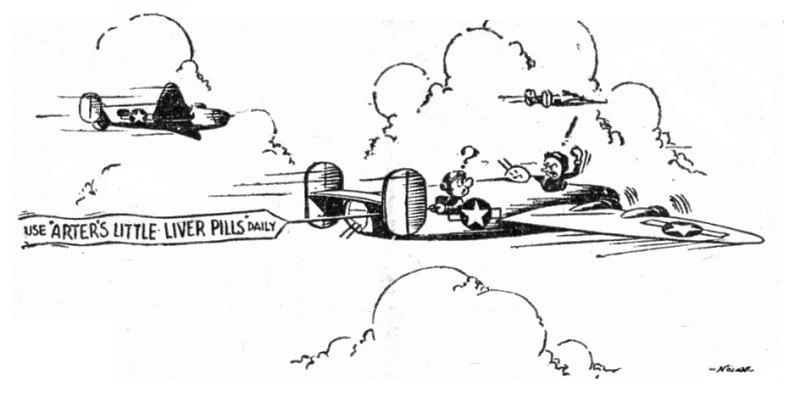
The C.B.I. Roundup is a weekly newspaper published by and for the men of the United States Army Forces in China, Burma, and India, from news and pictures supplied by staff members, soldier correspondents, the United Press, and the War Department. The Roundup is published Friday of each week and is printed by The Statesman in New Delhi, India. Editorial matter should be sent directly to Capt. Floyd Walter, Rear Echelon HQ., U.S.A.F., C.B.I., New Delhi, and should arrive not later than Monday in order to make that week's issue. Pictures must arrive by Sunday and must be negatives or enlargements. Stories should contain full name and organization of sender.

FEBRUARY 3, 1944
Original issue of C.B.I. Roundup shared by Ruth Canney, widow of CBI veteran John Canney.
Similar, better quality image of Carole Landis substituted for the original photo published in Roundup.
Copyright © 2007 Carl Warren Weidenburner
TOP OF PAGE PRINT THIS PAGE ABOUT THIS PAGE SEND COMMENTS
PREVIOUS ISSUE CLOSE THIS WINDOW NEXT ISSUE
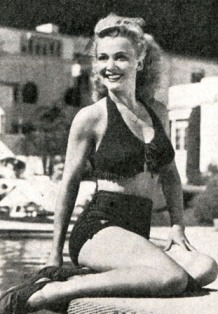 Some naive character asked the other day why the Roundup consistently publishes a cheesecake picture
(like today's) on page one. The reason, we'd say, is self-evident. Have another look, chum. The
gal is Carole Landis.
Some naive character asked the other day why the Roundup consistently publishes a cheesecake picture
(like today's) on page one. The reason, we'd say, is self-evident. Have another look, chum. The
gal is Carole Landis.
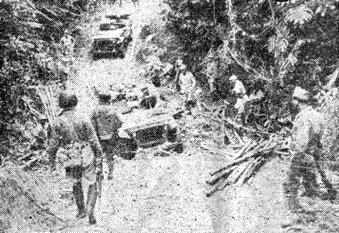 Lt. Gen. Joseph W. Stilwell and his Chinese guards are forced to pile out of their jeeps, despite chains, when they
bog down in the muck of a slippery jungle trail near the front lines.
Lt. Gen. Joseph W. Stilwell and his Chinese guards are forced to pile out of their jeeps, despite chains, when they
bog down in the muck of a slippery jungle trail near the front lines.
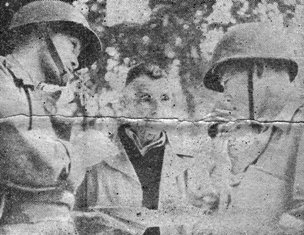 On the edge of a scarred, war-marked battlefield, Stilwell confers with two Chinese commanders, Lt. Gen. Sun Li-Jen,
divisional leader, is on his left, and Col. Lee Huang on his right.
On the edge of a scarred, war-marked battlefield, Stilwell confers with two Chinese commanders, Lt. Gen. Sun Li-Jen,
divisional leader, is on his left, and Col. Lee Huang on his right.
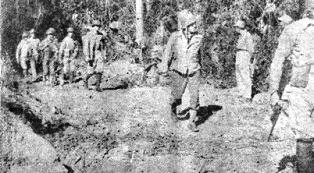 Stilwell walks back into Burma. Note the cocked German Luger pistols in the hands of the Chinese officers. Jap
ambushes would be sudden along jungle trails, so thick that visibility is limited to six feet.
Stilwell walks back into Burma. Note the cocked German Luger pistols in the hands of the Chinese officers. Jap
ambushes would be sudden along jungle trails, so thick that visibility is limited to six feet.
 Stilwell's party watches a formation of American planes roaring overhead en route to
dive-bomb Jap positions in the jungle. Other
planes drop vital supplies to the Chinese troops during their advance.
Stilwell's party watches a formation of American planes roaring overhead en route to
dive-bomb Jap positions in the jungle. Other
planes drop vital supplies to the Chinese troops during their advance.
